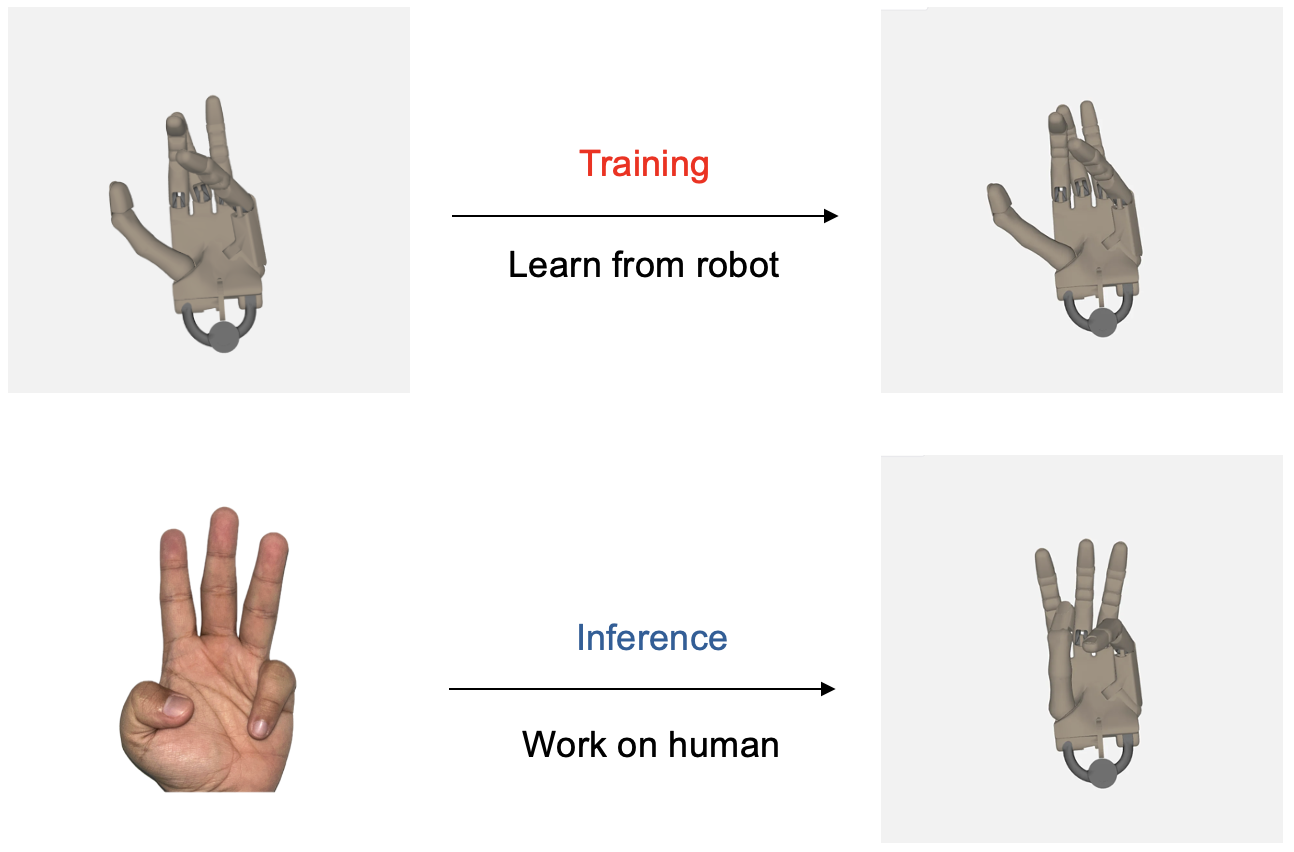🚀 Poseless-3B
A novel framework for robot hand control that bypasses pose estimation and enables cross - morphology generalization.

🚀 Quick Start
import torch
from PIL import Image
from transformers import AutoProcessor, Qwen2_5_VLForConditionalGeneration
from qwen_vl_utils import process_vision_info
device = "cuda" if torch.cuda.is_available() else "cpu"
model_path = "homebrewltd/Poseless-3B"
model = Qwen2_5_VLForConditionalGeneration.from_pretrained(
model_path,
trust_remote_code=True,
torch_dtype=torch.bfloat16
).eval().to(device)
processor = AutoProcessor.from_pretrained(
model_path,
min_pixels=256*28*28,
max_pixels=1280*28*28,
trust_remote_code=True
)
image = Image.open("your_hand_image.png").convert("RGB")
SYSTEM_PROMPT = """You are a specialized Vision Language Model designed to accurately estimate joint angles from hand pose images. Your task is to analyze images of a human or robotic hand and output precise angle measurements for each joint. Output joint angles in radians.
Output Format:
<lh_WRJ2>angle</lh_WRJ2><lh_WRJ1>angle</lh_WRJ1><lh_FFJ4>angle</lh_FFJ4><lh_FFJ3>angle</lh_FFJ3><lh_FFJ2>angle</lh_FFJ2><lh_FFJ1>angle</lh_FFJ1><lh_MFJ4>angle</lh_MFJ4><lh_MFJ3>angle</lh_MFJ3><lh_MFJ2>angle</lh_MFJ2><lh_MFJ1>angle</lh_MFJ1><lh_RFJ4>angle</lh_RFJ4><lh_RFJ3>angle</lh_RFJ3><lh_RFJ2>angle</lh_RFJ2><lh_RFJ1>angle</lh_RFJ1><lh_LFJ5>angle</lh_LFJ5><lh_LFJ4>angle</lh_LFJ4><lh_LFJ3>angle</lh_LFJ3><lh_LFJ2>angle</lh_LFJ2><lh_LFJ1>angle</lh_LFJ1><lh_THJ5>angle</lh_THJ5><lh_THJ4>angle</lh_THJ4><lh_THJ3>angle</lh_THJ3><lh_THJ2>angle</lh_THJ2><lh_THJ1>angle</lh_THJ1>
"""
messages = [
{"role": "system", "content": f"{SYSTEM_PROMPT}"},
{
"role": "user",
"content": [
{
"type": "image",
"image": image,
"min_pixels": 1003520,
"max_pixels": 1003520,
},
{"type": "text", "text": "<Pose>"},
],
},
]
text = processor.apply_chat_template(messages, tokenize=False, add_generation_prompt=True)
image_inputs, video_inputs = process_vision_info(messages)
inputs = processor(text=[text], images=image_inputs, videos=video_inputs, padding=True, return_tensors="pt").to(device)
generated_ids = model.generate(**inputs, max_new_tokens=1024)
generated_ids_trimmed = [out_ids[len(in_ids):] for in_ids, out_ids in zip(inputs.input_ids, generated_ids)]
output_text = processor.batch_decode(generated_ids_trimmed, skip_special_tokens=True, clean_up_tokenization_spaces=False)[0]
print(output_text)
The output will be joint angles in radians in XML format:
<lh_WRJ2>angle</lh_WRJ2><lh_WRJ1>angle</lh_WRJ1><lh_FFJ4>angle</lh_FFJ4>...
✨ Features
- Novel Framework: Leverage a VLM (e.g., Qwen 2.5 3B Instruct) to directly map monocular images to robot joint angles, bypassing pose estimation entirely. The VLM’s ability to "see" and project images enables robust, morphology - agnostic feature extraction, reducing error propagation inherent in two - stage pipelines.
- Synthetic Data Pipeline: Generate infinite training examples by randomizing joint angles and domain - randomizing visual features (e.g., lighting, textures). This eliminates reliance on costly labeled datasets while ensuring robustness to real - world variations.
- Cross - Morphology Generalization: Demonstrate the model’s ability to mimic human hand movements despite being trained solely on robot hand data, marking a significant step toward broader applications.
- Depth - Free Control: Provide evidence that depth - free control is possible, paving the way for later adoption with cameras that do not support depth estimation capability frequently used in robotics research.
📦 Installation
The installation process is mainly about setting up the Python environment and installing the necessary libraries. You can use the following commands:
pip install torch transformers pillow
📚 Documentation
Introduction
"PoseLess: Depth - Free Vision - to - Joint Control via Direct Image Mapping with VLM" (Paper) introduces a novel framework for robot hand control. It eliminates the need for explicit pose estimation by directly mapping 2D images to joint angles using projected representations. Our approach leverages synthetic training data generated through randomized joint configurations, enabling zero - shot generalization to real - world scenarios and cross - morphology transfer from robotic to human hands. By projecting visual inputs and employing a transformer - based decoder, PoseLess achieves robust, low - latency control while addressing challenges such as depth ambiguity and data scarcity. Experimental results demonstrate competitive performance in joint angle prediction accuracy without relying on any human - labelled dataset.
Key Contributions
- We introduce a novel framework that leverages a VLM (e.g., Qwen 2.5 3B Instruct) to directly map monocular images to robot joint angles, bypassing pose estimation entirely. The VLM’s ability to "see" and project images enables robust, morphology - agnostic feature extraction, reducing error propagation inherent in two - stage pipelines.
- We introduce a synthetic data pipeline that generates infinite training examples by randomizing joint angles and domain - randomizing visual features (e.g., lighting, textures). This eliminates reliance on costly labeled datasets while ensuring robustness to real - world variations.
- We provide evidence of the model’s cross - morphology generalization, demonstrating its ability to mimic human hand movements despite being trained solely on robot hand data. These findings mark a significant step toward understanding and leveraging such generalization for broader applications.
- We provide evidence that depth - free control is possible, paving the way for later adoption with cameras that do not support depth estimation capability frequently used in robotics research.
Model Details
| Property |
Details |
| Model Type |
Qwen 2.5 3B Instruct, fine - tuned for hand pose estimation |
| Training Data |
[homebrewltd/robot - hand - poses - train](https://huggingface.co/datasets/homebrewltd/robot - hand - poses - train) |
| Evaluation Data |
[homebrewltd/robotic - hand - poses - eval](https://huggingface.co/datasets/homebrewltd/robotic - hand - poses - eval) |
| License |
Apache - 2.0 license |
| Developers |
Alan Dao, Dinh Bach Vu, Tuan Le Duc Anh, Bui Quang Huy (Menlo Research) |
📄 License
This project is licensed under the Apache - 2.0 license.
📚 Citation
💡 Usage Tip
Contact the authors at alan@menlo.ai, bach@menlo.ai, charles@menlo.ai, yuuki@menlo.ai for further details.

